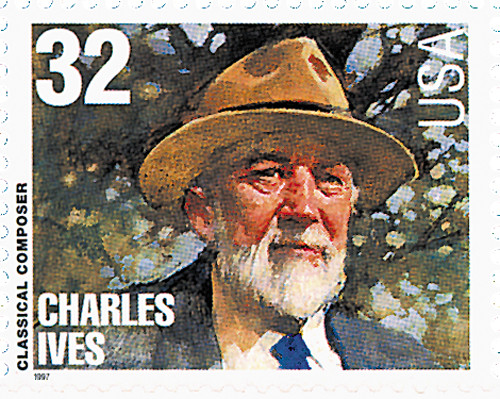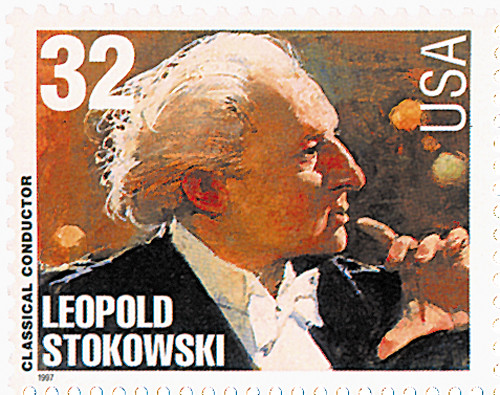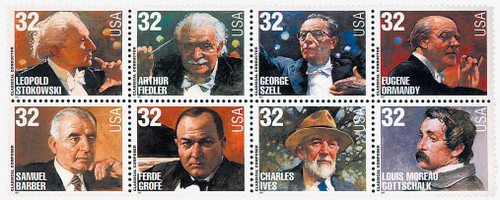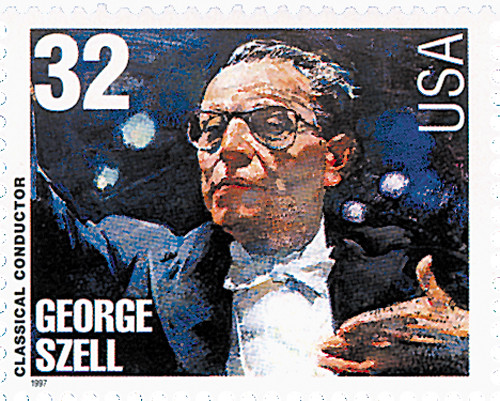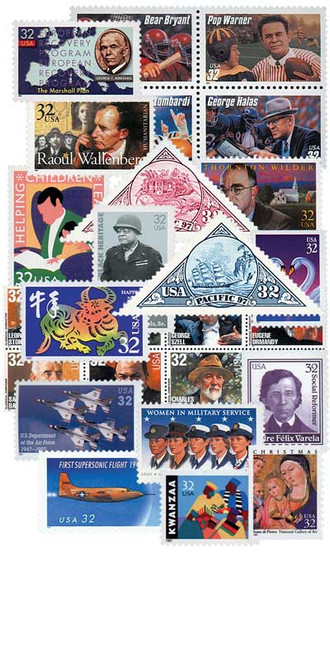
# 3164 - 1997 32c Conductors and Composers: Charles Ives, Composer
US #3164
1997 Charles Ives – Classical Composers & Conductors
American Music Series
- Pictures composer Charles Ives
- Part of the Classical Composers & Conductors set
- The 10th stamp set in the Legends of American Music series
Stamp Category: Commemorative
Set: Classical Composers & Conductors
Series: Legends of American Music
Value: 32¢, First Class Mail Rate
First Day of Issue: September 12, 1997
First Day City: Cincinnati, Ohio
Quantity Issued: 86,000,000
Printed by: Printed for Ashton Potter (USA) Ltd. By Sterling Sommer of Tonawanda, New York
Printing Method: Offset
Format: Pane of 20 (Horizontal 4 across, 5 down)
Perforations: 11.1 by 11.0
Tagging: Phosphored paper
Why the stamp was issued: To commemorate composer Charles Ives, one of the best of the best in American classical music.
About the stamp design: The stamp pictures a painting of Ives by artist Burt Silverman (also responsible for the image on the 1997 Raoul Wallenberg stamp). Art director Howard Paine said he chose Silverman because “He is a mature portrait painter… I didn’t want some glitzy, commercial, airbrush, flashy, tightly rendered kind of art…. Burt’s work is ‘painterly.’ He works in oil, and you can see dabs of color and you see brush strokes and you see the human touch.”
First Day City: The First Day of Issue Ceremony for the Classical Composers & Conductors stamps was held in Cincinnati, Ohio, at the Classical Music Hall of Fame. The city is also home to the Cincinnati Symphony Orchestra, then the fifth oldest symphony orchestra in the United States. It is also home to the Cincinnati Opera, the country’s second-oldest opera company.
About the Classical Composers & Conductors set: Issued to commemorate composers Samuel Barber, Ferde Grofe, Charles Ives, and Louis Moreau Gottschalk, as well as conductors Leopold Stokowsky, Arthur Fiedler, George Szell, and Eugene Ormandy. They were chosen to represent the best of the best in American classical music.
About the Legends of American Music Series: The Legends of American Music Series debuted on January 8, 1993, and ran until September 21, 1999. More than 90 artists are represented from all styles of music: rock ‘n’ roll, rhythm and blues, country and western, jazz and pop, opera and classical, gospel and folk. In addition to individual singers and Broadway musicals, subjects include band leaders, classical composers, Hollywood songwriters and composers, conductors, lyricists, and more. The Legends of American Music Series was a huge advancement for diversity because it honored many Black and female artists.
History the stamp represents: Charles Ives (1874-1954) began his musical education with his father, George, who had conducted an Army Band during the Civil War. His father encouraged experimentation, an attitude which would pervade his music. Experts rank Ives among America’s greatest and most original composers.
Although Ives composed his most important works from 1896 to 1921, and had pieces performed as early as 1925, he was not widely known until 1939. Many of his works are unconventional, with key and time signatures and bar lines omitted. One of Ives’ four symphonies, Symphony No. 3, won the 1947 Pulitzer Prize.
Many of Ives’ compositions were based on American folk and popular music, such as ragtime, military marches, patriotic songs, and revival hymns. He also put themes, such as baseball, to music – one of his 27 piano pieces is entitled Some Southpaw Pitching. Some of his music is reminiscent of the circus parades and revival meetings he heard while growing up in Danbury, Connecticut.
Interestingly, Ives never earned his living through music. After graduating from Yale in 1898, he entered the insurance business. He composed during his leisure time, and privately published his creations.
US #3164
1997 Charles Ives – Classical Composers & Conductors
American Music Series
- Pictures composer Charles Ives
- Part of the Classical Composers & Conductors set
- The 10th stamp set in the Legends of American Music series
Stamp Category: Commemorative
Set: Classical Composers & Conductors
Series: Legends of American Music
Value: 32¢, First Class Mail Rate
First Day of Issue: September 12, 1997
First Day City: Cincinnati, Ohio
Quantity Issued: 86,000,000
Printed by: Printed for Ashton Potter (USA) Ltd. By Sterling Sommer of Tonawanda, New York
Printing Method: Offset
Format: Pane of 20 (Horizontal 4 across, 5 down)
Perforations: 11.1 by 11.0
Tagging: Phosphored paper
Why the stamp was issued: To commemorate composer Charles Ives, one of the best of the best in American classical music.
About the stamp design: The stamp pictures a painting of Ives by artist Burt Silverman (also responsible for the image on the 1997 Raoul Wallenberg stamp). Art director Howard Paine said he chose Silverman because “He is a mature portrait painter… I didn’t want some glitzy, commercial, airbrush, flashy, tightly rendered kind of art…. Burt’s work is ‘painterly.’ He works in oil, and you can see dabs of color and you see brush strokes and you see the human touch.”
First Day City: The First Day of Issue Ceremony for the Classical Composers & Conductors stamps was held in Cincinnati, Ohio, at the Classical Music Hall of Fame. The city is also home to the Cincinnati Symphony Orchestra, then the fifth oldest symphony orchestra in the United States. It is also home to the Cincinnati Opera, the country’s second-oldest opera company.
About the Classical Composers & Conductors set: Issued to commemorate composers Samuel Barber, Ferde Grofe, Charles Ives, and Louis Moreau Gottschalk, as well as conductors Leopold Stokowsky, Arthur Fiedler, George Szell, and Eugene Ormandy. They were chosen to represent the best of the best in American classical music.
About the Legends of American Music Series: The Legends of American Music Series debuted on January 8, 1993, and ran until September 21, 1999. More than 90 artists are represented from all styles of music: rock ‘n’ roll, rhythm and blues, country and western, jazz and pop, opera and classical, gospel and folk. In addition to individual singers and Broadway musicals, subjects include band leaders, classical composers, Hollywood songwriters and composers, conductors, lyricists, and more. The Legends of American Music Series was a huge advancement for diversity because it honored many Black and female artists.
History the stamp represents: Charles Ives (1874-1954) began his musical education with his father, George, who had conducted an Army Band during the Civil War. His father encouraged experimentation, an attitude which would pervade his music. Experts rank Ives among America’s greatest and most original composers.
Although Ives composed his most important works from 1896 to 1921, and had pieces performed as early as 1925, he was not widely known until 1939. Many of his works are unconventional, with key and time signatures and bar lines omitted. One of Ives’ four symphonies, Symphony No. 3, won the 1947 Pulitzer Prize.
Many of Ives’ compositions were based on American folk and popular music, such as ragtime, military marches, patriotic songs, and revival hymns. He also put themes, such as baseball, to music – one of his 27 piano pieces is entitled Some Southpaw Pitching. Some of his music is reminiscent of the circus parades and revival meetings he heard while growing up in Danbury, Connecticut.
Interestingly, Ives never earned his living through music. After graduating from Yale in 1898, he entered the insurance business. He composed during his leisure time, and privately published his creations.

